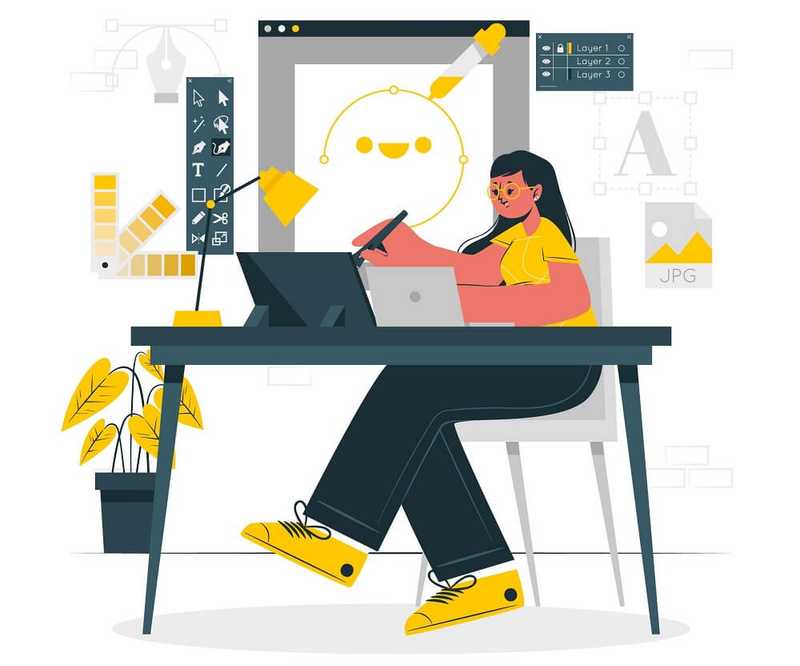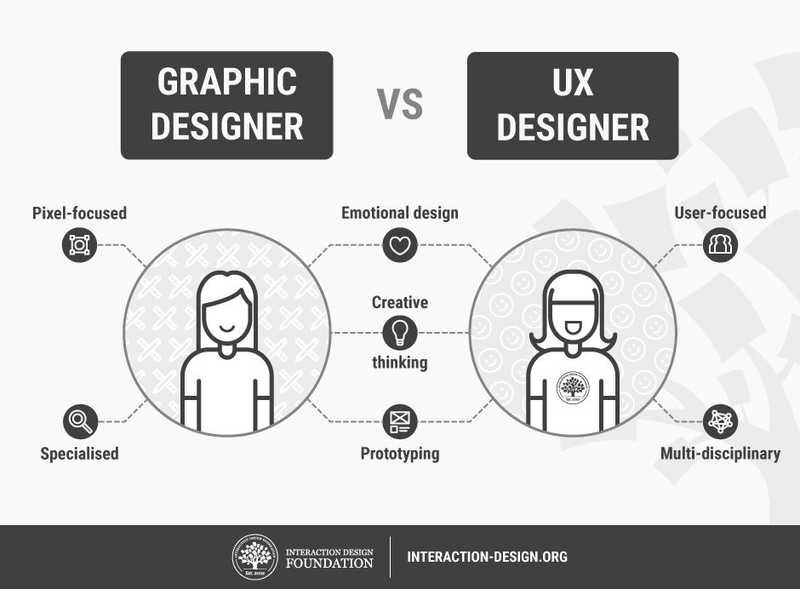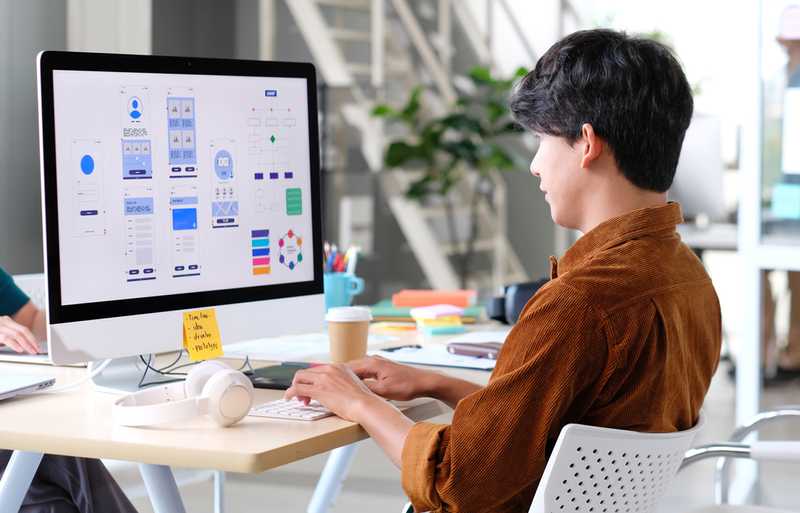7 Steps For Transitioning From Graphic Design to UI/UX Design

In this article
Graphic designers use design-thinking skills, like empathizing and prototyping, to create the face of our world. If you’re looking for a career change that uses your current skill sets and comes with a pay bump, then user experience (UX) design could be for you. Most graphic designers move to UX design or user interface (UI) design because some of their skills are transferable, and the demand and pay are both high.
A quick search on Indeed for graphic design jobs in the U.S. turns up almost 6,000 available positions, while UX designer roles are closer to 9,000. According to Payscale, UX designers have an average salary of $74,687 a year. It’s understandable why people make the shift. Below are seven steps that can help when transitioning from graphic design to UX design.
If you are currently in the field of graphic design and you are looking to transition into UX design, Here is a 7 step guide to help you make a smooth transition.
What Is UX Design and What Does a UX Designer Do?
UX design is a varied discipline that aims to create meaningful experiences and interactions for users by focusing on more than just the look and usability of an end product. The goal is to give the end-user a positive digital experience from start to finish, carefully considering every element that influences the way someone feels when using a product.
UX design builds a bridge between what companies have on offer and what potential customers need or want. Transitioning from graphic design to UI/UX design can be fulfilling. You get to use your existing skills and learn new ones to create the entire user experience. Your role will differ depending on where you work. However, UX designers have some core responsibilities, including:
- Conducting user and product research
- Building different personas of and scenarios for current users
- Defining information architecture or the structure of the end-product
- Creating a wireframe, which is a basic representation of a design
- Prototyping products by creating a more well-defined representation of them for testing purposes
- Testing the prototype to make final adjustments before release
- Providing continued maintenance of the user’s experience after the product is launched
7 Steps To Make a Career Transition From Graphic Designer to UX Designer

Source: Interaction Design Foundation
Switching careers takes courage and know-how but can be rewarding if it’s the right thing for you. Here’s a basic seven-step guide to transition from graphic design to UX design.
1. Take stock of your current skills
Aesthetics are as important as usability in the UX design process. If you can sketch a good app design with strong visuals, you can draw a user’s attention right away and create an emotional connection that leaves a lasting impression.
Your graphic design experience can give you an edge in the UX field. Make a list of your current skills, like ideation, emotional design, creative thinking, and problem-solving, to find your strengths and the gaps in your knowledge.
Also put together a list of programs you have experience with. Having a deep understanding of tools like Illustrator and Photoshop will give you a big edge over those unfamiliar with them.
2. Learn necessary UX skills
Once you know what sets you apart from the competition, you can start bridging the skills gap by acquiring the required UX skills. While graphic design is specialized, UX design is a multi-disciplinary process. You don’t have to know everything to make a shift, but educating yourself improves your chances of career success. Try opting for an online course to expand your skillset.
3. Begin a UX design portfolio
You don’t need a degree to become a UX designer but you will need an extensive portfolio. Newer graduates with many skills to showcase but no experience have a tendency to believe they need to find a UX job to fill their portfolios, but that’s not the only way to do it.
You can build your portfolio in a few ways:
- Complete personal projects
- Do work for nonprofit organizations
- Try to find an internship
- Participate in online UX design challenges and competitions
You’ll have a robust UX design portfolio in no time if you try a few of these.
4. Choose user-focused instead of pixel-focused design
As a graphic designer, the ultimate goal is pixel perfection, using skills like typography. When transitioning to UX design, you want to shed that habit and switch to user-focused design conventions. The key difference between these approaches is that your final design aims to solve a problem for the user, rather than just look appealing.
5. Learn how to conduct accurate user research
You’ll conduct a lot of research to create products that meet your users’ key needs, so find a course that teaches you this skill. Learning valuable user research techniques is crucial for success as a UX designer. Skilled designers use feedback as a tool to make adjustments and improvements that make everyone happy.
6. Network to help you stay connected with trends
Joining a community connects you with potential employers and mentors. Make sure you continue learning as you progress in your UX design career. Being in a community can help you keep up with trends and maintain your skills.
7. Start applying for jobs
Apply for jobs, and don’t be afraid to make the switch. It’s easy to get stuck in perfecting your skills and portfolio, but don’t let that keep you from taking the plunge when you’re confident you can land a job.
Get To Know Other Design Students
Aisha Butt
UX Associate at Meta
Talayeh Motameni
Senior UX Designer at United Airlines
Volkan Kantar
UX Designer at Microsoft
3 Most Important Skills To Become a UX Designer

You will need many skills to be successful as a UX designer, but these three are the most important.
1. UX research
User experience research is the cornerstone of UX design. You must know how to do it effectively to create visual designs that meet user needs. Fortunately, as a graphic designer, research is a large part of your job, so your skills can transfer over. You already know design-thinking processes, giving you an edge.
2. Collaboration
Being able to show empathy and effectively communicate with your team is crucial as a UX designer. Since it’s a multidisciplinary field, you’ll be working with many different people to create the best user experience possible. Collaboration skills cross over from your graphic design work, especially if you work on a creative team.
3. Wireframing and user UI prototyping
Wireframing and UI prototyping are crucial UX design skills. Working as a graphic designer gives you some user experience design knowledge. It’s important to learn how these skills are used in the context of interaction design. UI design principles are also valuable to understand.
Many of your graphic design skills are transferable skills that can help you move to a career in UX design.
Since you’re here…
Are you a future UX designer? Enroll in our UI/UX Bootcamp and join over 10,000 students who have successfully changed careers with us. Want to get wireframing right this second? Check out our free UX learning path today.





